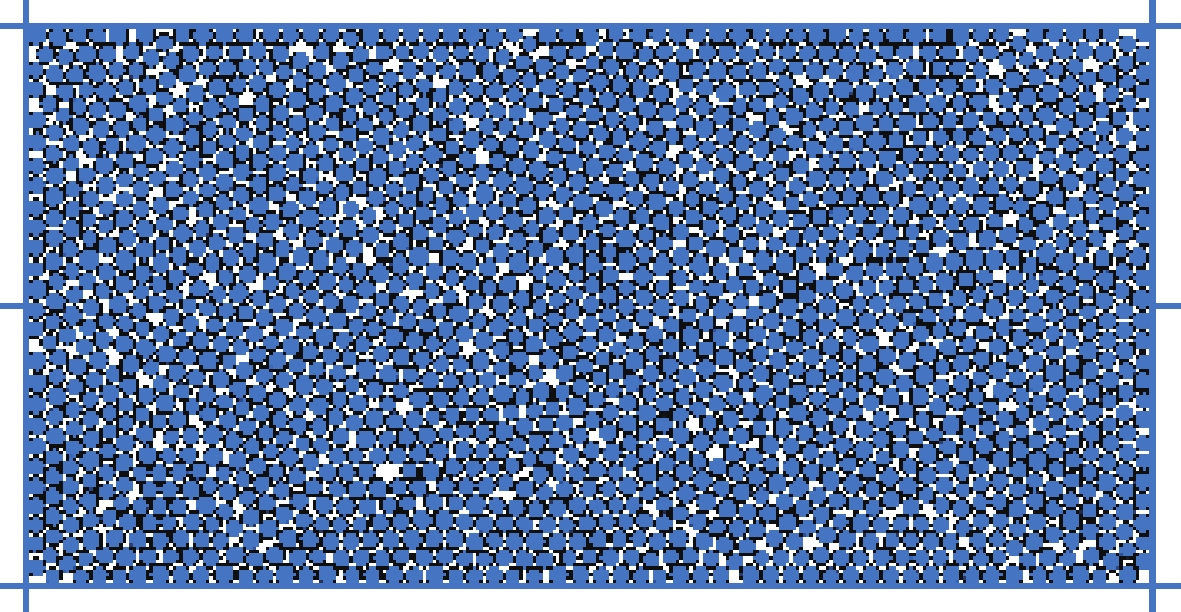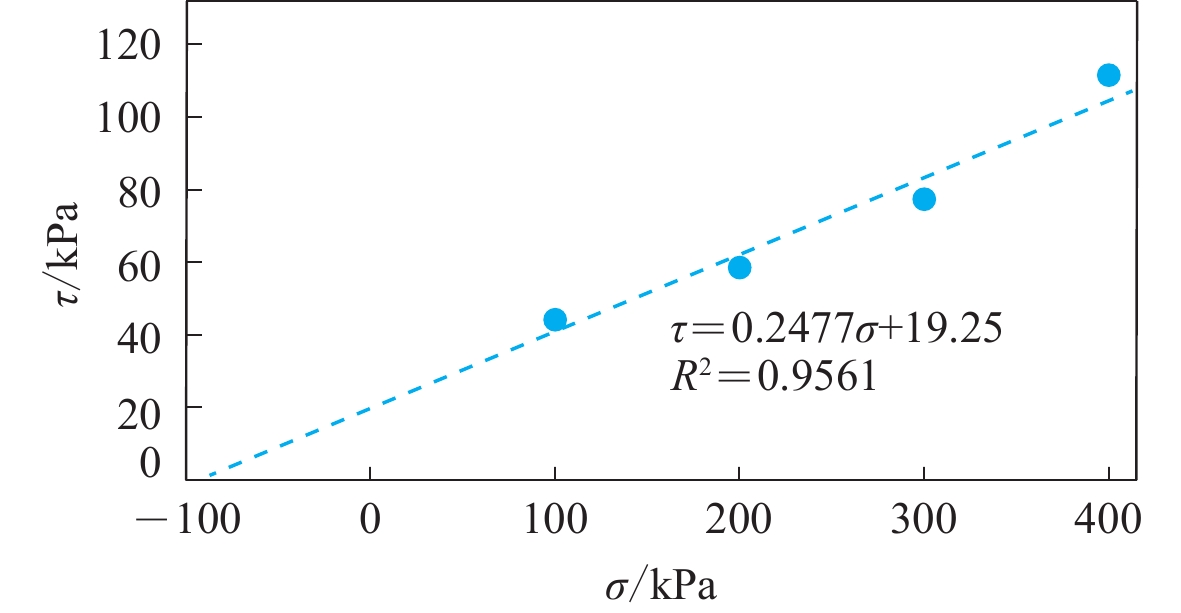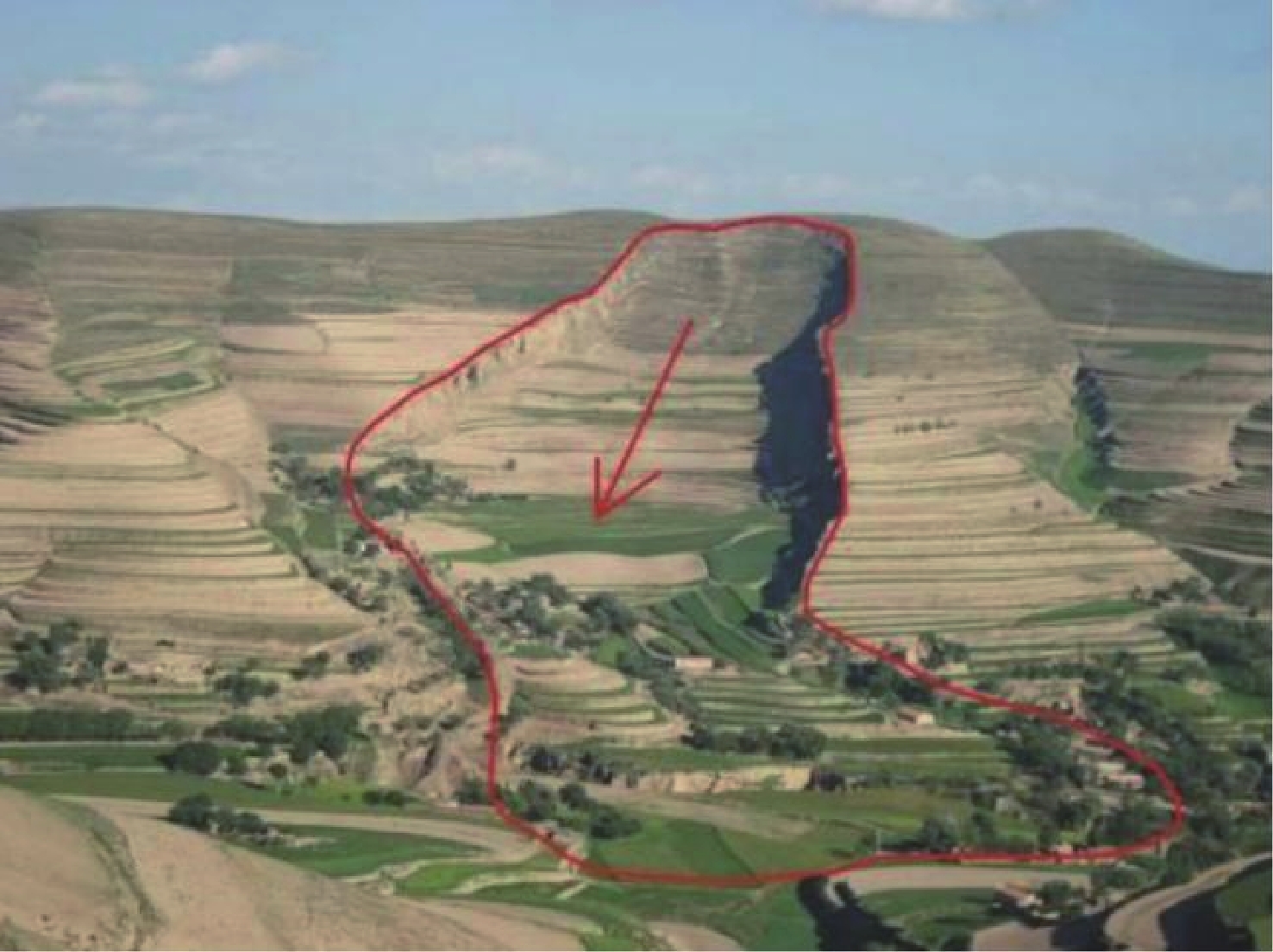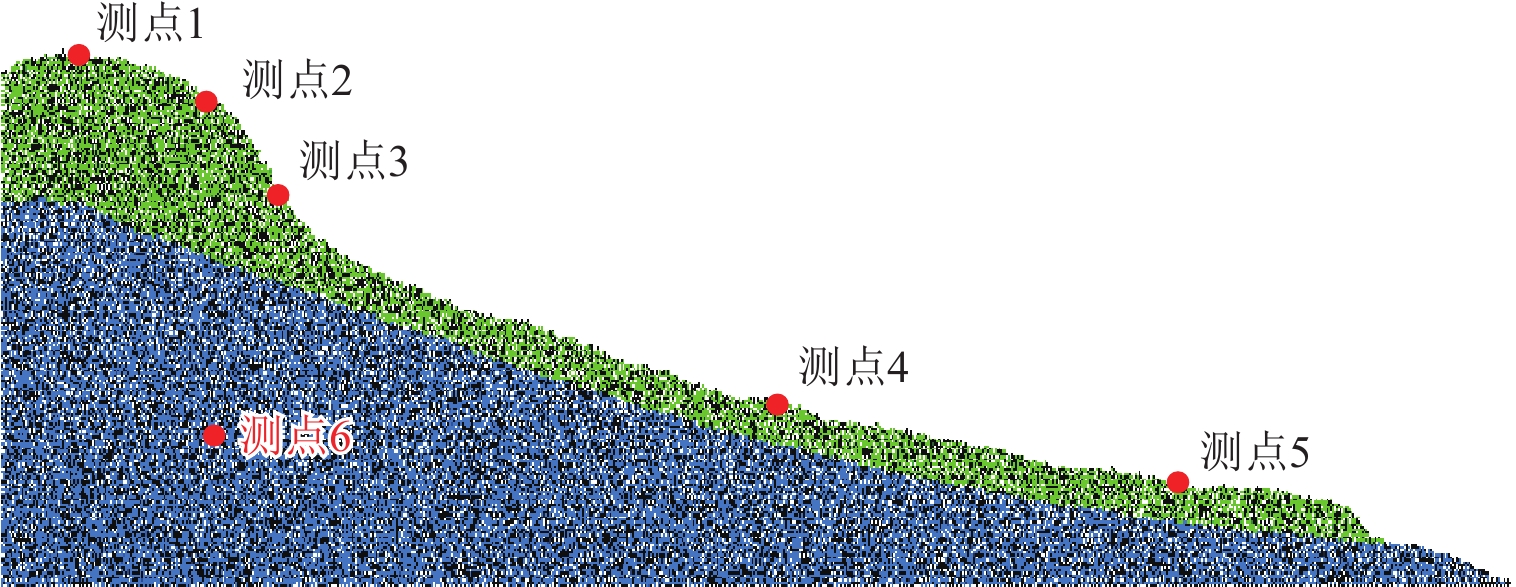Numerical simulation of earthquake-induced loess landslides based on particle flow method
-
摘要: 基于颗粒流理论研究土质边坡动力稳定性及其滑动过程是近年来滑坡研究的一个新热点。在野外调查和室内试验的基础上,通过标定土体细观参数、模型建立、动力输入、动态监测等过程,利用PFC2D程序模拟了西吉县兴平乡堡湾村下马达子滑坡的失稳破坏运动过程,得到了该滑坡的破坏运动机理。得到如下结论:① 下马达子滑坡的失稳机制是在地震作用下斜坡前缘牵引、后缘推挤,使得坡肩受拉发生破坏,失稳后坡肩位置较大的速度和位移是地震滑坡破坏力强、致灾范围大的主要原因;② 黄土地震滑坡的滑坡后壁相对平缓,这是区别于重力滑坡的重要特征之一;③ 颗粒流模拟得到的滑坡前后相对高差和长度与实际情况较为吻合,因此,颗粒流方法可以用于地震滑坡滑距的预测。Abstract: Research on the dynamic stability and sliding process of soil slopes based on particle flow theory is a new hot spot in landslide research in recent years. On the basis of field investigation and indoor experiment, the PFC2D program was used to simulate the instability failure movement process of the Xiamadazi landslide in Baowan village, Xingping township, Xiji county through the process of calibrating soil parameters, model establishment, power input, dynamic monitoring, etc., and the failure movement mechanism of the landslide is obtained. The following conclusions are obtained: ① The instability mechanism of the Xiamadazi landslide is that under the action of the earthquake, the leading edge of the slope is pulled and the trailing edge is pushed, causing the shoulder to be pulled and damaged. The larger velocity and displacement at the shoulder position after the instability is the main reason for the strong destructive force and the large disaster range of the earthquake landslide; ② The back wall of the earthquake-induced loess landslides is relatively flat, which is one of the important characteristics different from gravity landslides; ③ The relative altitude difference and length before and after the landslide obtained by particle flow simulation is more consistent with the actual situation. Therefore, the particle flow method can be used to predict the slip distance of earthquake landslides.
-
引言
地下水作为地壳结构中最活跃的组分之一,具有较好的流动性和难压缩性。当在含水层周围形成一个封闭条件较好的承压系统时,地下水的升降就能十分客观地反映出周边区域地壳应力应变的状态。同时自1988年至今所出版的 《中国震例》 报告(张肇成等,1988,1990a,b,1999,2000;陈棋福等,2002a,b,2003,2008;蒋海昆等,2014)中的统计结果显示,中强地震前普遍存在地下水位异常,因此,我们可以通过记录到的地下水位动态序列来研究周边含水岩体在地震发生之前的受力、变形和破坏过程(汪成民等,1988;付虹等,2014)。
正常观测得到的地下水位动态变化是在多种因素影响下产生的综合物理量,既包括水位的宏观动态变化,也包括微观动态变化,其中宏观动态变化主要是由含水层中储水量的改变引起的变化,微观动态变化则主要是由周边岩体的应力应变状态改变而引起的变化,因此,地下水位的异常变化形态有可能是周边环境干扰等引起的干扰变化,也可能是区域构造活动引起的前兆异常变化(贾化周等,1995;孙小龙等,2013)。如何排除这些干扰因素的影响,识别出与构造活动有关的地下水微动态,进而判断地下水异常产生的机理,是目前地下流体资料分析应用的关键科学问题之一(车用太等,2011)。
一般情况下,水位的宏观动态变化主要与观测井周边的地下水补给、径流和排泄状态密切相关,在日常研究中最为常见的因素包括地下水开采和大气降水等(车用太等,1993;晏锐,2008;杨明波等,2009;胡小静等,2016),经过多年的实践,研究人员提出并尝试了不同的分析方法来排除降水对水位数据变化的影响,包括卷积滤波法(张昭栋等,1993)和组合水箱模型法(王旭升等,2010;孙小龙等,2013)等,在实际应用中均取得了一定的实用效果;对于引起水位微观动态变化的构造活动,除了用各类地球物理场观测资料来描述地壳形变和构造活动之外,许多研究人员也尝试在不同区域,利用数字化观测的承压井水位动态资料,通过计算含水层的部分介质参数,来反演该区域内的构造活动和应力应变状态,从而分析探寻与地震有关的部分前兆信息,并积累了一定的经验和成果(李永善,1979;孙小龙等,2011;丁风和等,2015b)。
滇南地区高大、开远、易门3井的井水位自2014年以来出现的趋势转折上升现象到底是环境干扰所致还是由构造活动所引起的前兆异常信息,针对此问题,笔者拟从降水影响定量排除、观测环境调查、井孔含水层和区域应力场状态以及井孔水体化学组分等方面进行分析,探讨目前水位趋势上升异常的发生机理。
1. 观测井及水位异常概况
高大井、开远井和易门井在大的构造区域上,集中位于川滇菱形块体的东南角。从活动断裂带来看,高大井位于通海—峨山断裂带上,地处1970年通海MS7.8大震的极震区;开远井位于个旧断裂和开远—蒙自断裂附近,地处小江断裂与建水—石屏弧形断裂交叉、复合部位;易门井位于南华—楚雄—建水断裂带上(图1)。井孔柱状图结果显示(云南省地震局,2005),高大井目前实际井深约为201.4 m,井孔观测的含水层位于166—194 m处,岩性属震旦系微红组石英岩,地下水类型为基岩裂隙承压水,岩芯分析结果显示整个含水层处于受控制的强挤压断裂破碎带内;开远井深224 m,井孔观测的含水层有两段,分别位于96—100.36 m和169.38—224 m处,岩性属三叠系的灰岩,地下水类型为岩溶裂隙承压水,岩心结构显示50—90 m左右存在断层碎屑物,可能是断裂穿过井孔所致;易门井井深约为155 m,井孔观测的含水层分别位于96.31—102.47 m和122.64—159.58 m处,岩性属昆阳群板岩,地下水类型为基岩裂隙承压水。
高大井和开远井的井水位自观测以来,呈现出雨季上升、旱季下降的年变形态,含水层补给类型属降雨渗透补给型,2014年以来高大井和开远井的井水位出现趋势转折上升现象,截至2017年8月,水位持续上升幅值已分别达到1.5 m和4.3 m,目前水位保持在高位状态(图2)。
从数据分析的结果来看,引起水位趋势上升最常见的两类原因为:一是周边观测环境改变引起的干扰变化,包括本区域降水量逐年增多、观测井周边地下水开采量的减少等引起观测井含水层内水量的增多,从而引起观测井水位的上升;二是区域应力场改变构造活动导致地壳的岩体产生变形,使得含水层固体骨架之间的孔隙压增大,从而导致观测井水位出现持续上升现象。
2. 水位变化与环境影响分析
2.1 水位变化与降雨影响分析
2.1.1 水位变化与降水相关性分析
从水位与降雨量的同轴曲线(图2)可知,3口井的水位在大多数年份均表现为雨季上升、旱季下降的年变形态,表明井水位与降水之间的关系较为密切,但从图中也可以看出,水位变化在个别年份也会表现出与雨季、旱季不一致的变化形态,例如:高大井水位在2015,2016年间出现过旱季水位持续上升的现象,开远井水位在2014,2016年间出现过旱季水位持续上升的现象,而易门井水位则在2013年连续3个月的雨季期间持续下降,表明这3眼井近几年的水位变化除了受降水影响以外,还存在其它的影响因素。
为了进一步分析降水与水位变化之间的相关性,利用月累积降雨量与月均水位变化量作线性回归,拟合出二者之间的线性关系,y=ax±b。其中,y为水位观测的月均变化量,x为水位观测的月累积降雨量,当水位月变幅值超出拟合线一定范围时,则认为水位变化与降水之间的相关性较小。从月累积降雨量与月均水位变化量的线性回归拟合可以看出,这3眼井的水位与降水呈现了较好的线性相关,与云南地区部分观测井水位对降雨响应的滞后时间长达4个月相比,这3口井的响应过程相对更快,但仍然存在数天的滞后现象,不过依然保持着雨季上升、旱季下降的年变形态。但高大井水位在2007—2008年间和2012—2016年间均出现了水位变化量与降雨影响幅值明显不吻合的现象;开远井水位在2012,2014—2016年间出现了水位变化量与降雨影响幅值不吻合的现象;易门井水位在2007,2012—2016年间出现了水位变化量与降雨影响幅值不吻合的现象(图3)。
2.1.2 利用降水量反演水位动态变化
王旭升等(2010)针对水位变化对降水响应滞后的观测井孔,提出了降雨-水位动态的组合水箱模型,其可通过当地降水量资料来反演地下水位的动态变化过程。该模型主要通过伽玛分布密度函数所建立的单位脉冲响应函数来处理降水补给滞后的影响,并将地下水位观测得到的实际变化形态与反演计算得到的模拟变化动态进行对比,从而来定量地剔除降水量对水位动态变化的影响。孙小龙等(2013)利用该模型,对姚安井水位资料的降雨干扰进行了定量剔除,得到了比较理想的反演结果。
笔者也尝试利用该模型,根据当地的月累积降雨量变化对高大、开远和易门3口井的水位变化进行反演,得到3口井水位的模拟值,并与去趋势之后的原始水位观测值进行对比(图4),从图4可以看出,易门井水位年动态受降水影响非常显著,而高大和开远井的水位年动态明显偏离模拟值,因此,仅从降水量补给角度看,易门井水位年动态主要受控于降水量,降水增多引起其趋势上升,而高大井和开远井的水位年动态除了受降水影响之外,在很大程度上还受其它因素的控制。
2.2 观测井周边地下水开采情况调查分析
自2009年以来,云南地区干旱严重,滇南地区作为旱区之一,新打机井几百眼,主要用于农业灌溉等,其中也存在部分深井。早在2013年水位处于下降过程时,付虹等(2014)便对开远井周边的抗旱打井抽水情况进行过调查,并对距离开远井最近的(约5 km)1口深井的抽水情况进行了定量估算,结果显示该深井抽水的影响范围远小于5 km。笔者于2017年再次对这3眼井周边地下水的开采情况进行了详细调查,调查结果显示:高大井和开远井所在坝区在2009年左右的干旱年份均未曾开挖抗旱井,已有的居民用井开挖深度均在10 m左右,与观测井含水层不在同一层位,用水量多年基本保持不变,因此,由高大井和开远井附近含水层内水量在2014年前后并未增多可知,这两口井附近的地下水开采并未减少。
易门井周边地下水开采情况调查结果显示,在观测井东北方约3 km处为大椿树工业园区,园区内建有多家水泥厂和家具建材生产、销售基地,共打水井21口,井深大多在150 m左右,长期使用水泵进行抽水,直至2016年10月由当地政府将21口抽水井统一封存。对易门井周边大椿树工业园区内深井抽水情况进行具体分析可知:① 从工业园区内深井开挖的进程来看,在2002—2003年间,随着工业园区内开挖的深井明显增多,水位出现明显的趋势下降,2009—2010年间,随着深井开挖的另一个高峰,水位趋势下降的速率更为明显,至2012年县政府限制深井的开挖和抽水之后,水位出现短暂的回升,趋势下降过程有所减缓,2014年之后完全停止新井的开挖,水位出现了明显的转折回升过程,至2016年10月,工业园区内抽水深井被全部封存,水位保持持续回升的过程。整个工业园区内深井开挖和抽水的发展进程与易门井水位趋势下降后转折回升的过程在时间上比较吻合(图5);② 从抽水层与观测井含水层的对比来看,工业园区附近海拔为1 610 m,而井深大多在100—150 m左右,因此大量抽水层均位于1 460—1 510 m左右,观测井海拔为1 580 m,基础资料显示,该井含水层位于井孔下96.31—102.47 m,因此其含水层位于海拔1 483—1 478 m处,对比抽水层与观测井含水层,抽水层恰好位于观测井的含水层处。结合深井开挖进程和抽水层位进行分析认为,易门井水位变化动态受大椿树工业园区内深井抽水的影响较为明显。
从上述关于降水影响和地下水开采影响的分析结果可以看出,易门井井水位年动态主要受控于降水过程,整个趋势下降变化与大椿树工业园区的深井开挖及抽水关系非常密切;高大井和开远井井水位的年动态和趋势上升变化不完全受控于降水影响,与周边抗旱井地下水开采使用亦无直接联系。
3. 井孔周边构造活动特征分析
根据已有的研究结果,水位上升过程除了受降水和地下水开采的影响之外,很有可能还与周边的构造应力状态有关,因此,笔者进一步定量计算了3口井井孔含水层系统的垂直向应力场的动态变化过程,并收集了滇南地区的GPS观测结果,对异常井井孔周边的构造活动和应力场状态进行分析。
3.1 基于井孔含水层应力变化的构造活动特征
根据前人的研究成果(李永善,1979;孙小龙等,2011;丁风和等,2015b),在理想的承压含水层模式下,井孔含水层垂直向的应力变化量Δσz与含水层部分介质参数和井水位变化量之间存在定量关系,并且能在一定程度上反映出该区域的构造活动特征,即
$\Delta {\sigma _{{\textit z}}} {\text{=}} \frac{{ {\text{-}}2\beta \rho {\rm{g}}}}{{n\beta {\text{+}} {\displaystyle\frac{1{\text{-}} n} {E}}}}\Delta H{\text{,}}$


(1) 式中:Δσz为含水层垂直向应力变化量;ρg为水的重度,在研究过程中取9.8×103 N/m3;ΔH为剔除长趋势和年周期变化后,含水层应力变化引起的压力水头变化量,即井水位变化量;n为含水层的孔隙度;β为水的体积压缩系数;E为含水层固体骨架的弹性模量,E=1/α,α为固体骨架的体积压缩系数。
上述参数中,n,β,α即为含水层的部分介质参数,它们之间的关系表达式可通过气压系数和潮汐因子之间的关系推算得到(丁风和等,2015a,c)。具体的推算和拟合过程如下:在仪器设备和观测环境正常的情况下,井水位的潮汐因子Bg和气压系数BP可分别表示为
${B_{\rm{g}}} {\text{=}} {\text{-}} \frac{{1 {\text{-}} n}}{{\rho {\rm g}\left[ {(1 {\text{-}} n)\alpha {\text{+}} n\beta } \right]}}{\text{,}}{B_{\rm P}} {\text{=}} \frac{{n\beta }}{{\alpha {\text{+}} n\beta }}{\text{,}}$


(2) 式中:潮汐因子Bg选择地球固体潮中振幅最大、信噪比最高的M2波作为计算对象,通过维尼迪柯夫(Venedikov)潮汐调和分析获取;气压系数BP主要利用水位数据和同井观测的气压数据经过滤波和差分,再通过线性回归模型进行拟合后获取;最后经过滑动推算得到含水层孔隙度n与水的体积压缩系数β之间的关系,以及固体骨架的体积压缩系数α。
从物理意义及异常性质判定来讲,当井孔含水层系统所受应力增强,即Δσz>0时,井水位上升,水位埋深变小,其变化量ΔH<0;当井孔含水层系统所受应力减弱,即Δσz<0时,井水位下降,水位埋深变大,其变化量ΔH>0。
笔者利用文中3眼水位观测井的气压系数和M2波潮汐因子等参数,反演得到井孔含水层部分介质参数,在水平层状含水层模式下,定量地计算了2007年以来高大、易门和开远3口观测井的垂直向应力场的动态变化过程(图6)。计算结果显示,自2014年以来,高大井、开远井、易门井的含水层系统的应力状态均以压应力为主,表现为水位上升、水位埋深变小,表明该区域内近几年以持续的应力增强活动为主。从历史震例可以看出(表1),2007—2008年间水位观测井孔的含水层出现了应力增强之后,在云南和川滇交界地区先后发生了2008年会理MS6.1地震和2009年姚安MS6.0地震;2012年再次出现应力增强之后,2013年发生了四川芦山MS7.0地震;2014年以来在应力的持续增强过程中,云南地区先后发生了鲁甸MS6.5和景谷MS6.6等多次6级地震,2017年井孔垂直向应力仍保持增强状态。历史震例统计情况表明,井孔含水层应力增高,确实可以在一定程度上反映出区域范围内构造应力增强的过程,同时也有利于地震的发生。
表 1 井孔应力增强与周边地震的对应情况统计Table 1. Statistical analysis of the correspondence between the stress enhancement of observation wells and surrounding earthquakes序号 井孔名称 异常开始时间 异常结束时间 异常幅值/105 Pa 发震日期 震例 年−月−日 1 高大 – – – 2007−06−03 宁洱MS6.4 开远 2007−03 2007−05 0.036 1 易门 2007−05 2008−04 0.045 7 2 高大 – – – 2008−08−30 会理MS6.1 开远 2008−02 2009−01 0.055 0 易门 2007−05 2008−04 0.045 7 3 高大 2009−05 2009−12 0.001 96 2009−07−09 姚安MS6.0 开远 2007−03 2009−01 0.055 0 易门 – – – 4 高大 2012−01 2012−12 0.012 9 2013−04−20 芦山MS7.0 开远 2012−06 2012−12 0.005 4 易门 2012−03 2012−09 0.003 0 5 高大 2014−01 2017−05 (未结束) 0.087 4 开远 2013−10 2017−01 0.125 0 2014−08−25
2014−10−07鲁甸MS6.5
景谷MS6.6易门 2014−03 2017−05 (未结束) 0.049 0 注:截至结算结果日期2017年5月,高大井和易门井的高应力状态仍未结束。 3.2 基于GPS观测数据的区域构造活动特征
陈立德和付虹(2003)的研究结果表明,前兆异常均为区域应力水平增强的产物。当区域应力水平出现改变,构造活动增强时,地下水位就可能出现趋势性的异常变化。根据同期云南省地震局形变测量中心的GPS解算结果,布设于滇中—滇南块体中自北向南的昆明—通海基线和通海—蒙自基线自2014年以来呈现出明显的压缩状态(图7),表明整个块体的南北向挤压应变积累较强,以压性活动特征为主,目前的异常井孔恰好位于两条基线观测区间内(图1)。根据已有的研究成果(刘耀炜等,2010;付虹等,2014),如果岩层被挤压,则岩层的孔隙率变小,孔隙水压增大,水流由含水层向井孔流动,从而使水位上升。据此分析认为,高大井和开远井井水位自2014年以来的趋势性上升过程可能与整个块体南北向强挤压为主的构造活动存在一定的相关性。
4. 井孔水化学特征分析
为了进一步判定目前观测井水体中的水-岩相互作用程度,并希望以此来判断观测井水体中是否携带来源于深部构造活动的物质成分,笔者于2016年12月对3眼观测井进行了取样,取样深度均为水面以下1 m,并委托云南省地震局防灾研究所实验室和中国地震局防灾科技学院流体实验室分别对水样的水化学成份和氢氧同位素进行了测试,化验结果分析如下。
从水化学三线图(图8a)可见,3口井的地下水类型均属于重碳酸型水,反映了浅层、年龄较轻的水文循环特征,但相比于易门井,高大井和开远井的Na++K+的相对含量明显高于易门井,而Ca2,Mg2+的相对浓度则远低于易门井。根据离子之间的反应过程可知,当观测井中水体与含水层中的岩体之间发生深度接触时,水体中的Ca2+,Mg2+会发生一系列被吸附和交换的过程,从而释放出更多的Na+,使得含水层水体中Ca2+,Mg2+含量明显减少,而Na+含量则显著升高。因此,水化学Piper图的结果表明,高大井和开远井的含水层水体与岩体之间的相互作用比较充分,二者之间的平衡程度也较高;而易门井则是以典型的大气水与岩石之间的第一阶段反应为主。
从水样的Na-K-Mg三角图(图8b)可见,高大井的地下水比较接近“部分平衡水”状态,其水-岩相互作用程度相对较高,携带了部分深部构造活动的信息;易门井的地下水则位于Mg2+端元附近的“未成熟水区域”,表明该井的含水层水体与岩体之间的相互作用程度非常弱,二者之间仍在发生着相互溶解和交换的过程,所携带的深部信息较少;开远井虽然也处于“未平衡水状态”,但相比易门井,已有所偏离Mg2+端元,因此也存在一定的水-岩相互作用。
从氢氧同位素对比图(图8c)来看,3口井均位于西南地区大气降水线右侧,表现为δ18O富集特征(正向漂移)。对于该现象,根据现有的研究结果,推测其可能的形成原因主要有两种:一是由于该区域正处在降水量小而蒸发作用较强的时段,这在干旱、半干旱地区表现的较为突出;二是由于地下水体与岩体之间长期以来发生了较为充分的相互作用,使得水体中的氢氧同位素之间发生了平衡交换。考虑到云南地区近几年雨水较为丰富,蒸发过程偏弱,因此分析认为氢氧同位素正向漂移现象很有可能是深部构造活动引起水岩反应的结果。
5. 讨论与结论
通过对滇南地区高大井、开远井和易门井3眼水位观测井自2014年以来出现的水位趋势转折上升现象进行观测环境、大气降水、构造活动影响以及水化学组分等方面的分析,得到如下认识:
1) 自2014年以来高大井、开远井和易门井井水位出现趋势上升,对水位变化与降水的相关性分析显示,高大井、开远井和易门井在短期内曾多次出现水位变化明显偏离降雨影响范围的上升过程,表现为与同期降水不完全相关的特征;利用降水-水位动态的组合水箱模型进行了降水影响定量排除,结果显示,易门井井水位年动态主要受控于降水量,而高大和开远井的水位年动态除了受降水影响之外,其它因素对其影响更大。
2) 周边观测环境调查结果的相关性分析显示,易门井井水位的整体趋势下降与转折上升过程与易门大椿树工业园区的深井开挖抽水密切相关,高大和开远井井水位的年动态和趋势上升变化不受周边抗旱井及地下水开采使用等环境的影响。
3) 在水平层状含水层模式下,3眼观测井的垂直向应力场的反演结果显示,自2014年以来,高大井、开远井和易门井的含水层系统的应力状态均表现为应力持续增强。历史震例表明,井孔含水层应力增高,确实可以在一定程度上反映出区域范围内构造应力积累的过程。GNSS基线观测结果同样表明,自2014年以来,异常井孔所处的整个滇中—滇南块体自北向南以明显的压性活动为主。
4) 水化学组分和氢氧同位素分析结果表明,高大井和开远井地下水的水-岩相互作用程度较高,水体中存在一定的来源于深部构造活动反应的物质成分;易门井地下水的水-岩相互作用比较弱,基本以浅层的溶解作用为主。
5) 结合上述几个方面的分析,笔者认为高大井、开远井的井水位自2014年以来的趋势转折上升现象不完全为降水影响所致,从水体的循环深度较深且携带有深部构造活动的物质成份以及GPS显示井孔所处区域地块的挤压现象等初步判定,这两眼井的水位趋势上升与区域构造活动有关,因此需作为异常继续观察;而易门井虽然曾经出现过的高应力状态也与地震有关,但因水位年动态与降水影响完全一致,趋势下降和转折上升与大椿树工业园区的深井开挖抽水关系也非常密切,因此认为其与深部的构造活动关系不大。
本文在撰写过程中,得到了宁夏回族自治区地震局丁风和副研究员、中国地震局地壳应力研究所孙小龙博士和中国地震台网中心周志华博士的指导和帮助,作者在此表示衷心的感谢!
-
表 1 土工试验参数
Table 1 Geotechnical test parameters
岩性 饱和密度/(g·cm−3) 孔隙比 含水率 饱和度 液限 塑限 压缩模量/MPa 黏聚力/kPa 内摩擦角/° 黄土 2.00 0.62 19.6% 86% 29.4% 18.5% 9.59 18.9 14 表 2 细观试验参数
Table 2 Micro-scale test parameters
颗粒半径
/m颗粒密度
/(g·cm−3)阻尼比 摩擦系数 法向刚度
/MPa切向刚度
/MPa平行黏结参数 抗拉强度/Pa 黏聚力/Pa 摩擦角/° 摩擦系数 0.01—0.05 2 400 0.5 0.5 50 70 4×105 2×105 45 0.5 -
薄景山,段玉石,常晁瑜,李孝波,彭达,闫东晗. 2019. 斜坡地震稳定性研究的若干问题[J]. 自然灾害学报,28(1):1–8. Bo J S,Duan Y S,Chang C Y,Li X B,Peng D,Yan D H. 2019. Some problems of study on slope stability under earthquake[J]. Journal of Natural Disasters,28(1):1–8 (in Chinese).
曹文,李维朝,唐斌,邓刚,李俊峰. 2017. PFC滑坡模拟二、三维建模方法研究[J]. 工程地质学报,25(2):455–462. Cao W,Li W C,Tang B,Deng G,Li J F. 2017. PFC study on building of 2D and 3D landslide models[J]. Journal of Engineering Geology,25(2):455–462 (in Chinese).
常晁瑜,杨顺,焦淙湃,彭达. 2019. 1920年海原特大地震诱发黄土滑坡滑距统计与预测分析[J]. 防灾科技学院学报,21(2):36–43. doi: 10.3969/j.issn.1673-8047.2019.02.006 Chang C Y,Yang S,Jiao C P,Peng D. 2019. Sliding distance statistics and prediction of the loess landslide triggered by the 1920 Haiyuan earthquake[J]. Journal of Institute of Disaster Prevention,21(2):36–43 (in Chinese).
常晁瑜,薄景山,李孝波,乔峰,闫东晗. 2020. 地震黄土滑坡滑距预测的BP神经网络模型[J]. 地震工程学报,42(6):1609–1614. doi: 10.3969/j.issn.1000-0844.2020.06.1609 Chang C Y,Bo J S,Li X B,Qiao F,Yan D H. 2020. A BP neural network model for forecasting sliding distance of seismic loess landslides[J]. China Earthquake Engineering Journal,42(6):1609–1614 (in Chinese).
陈达,薛喜成,魏江波. 2018. 基于PFC2D的刘涧滑坡破坏运动过程模拟[J]. 煤田地质与勘探,46(4):115–121. doi: 10.3969/j.issn.1001-1986.2018.04.019 Chen D,Xue X C,Wei J B. 2018. Simulation of failure process of Liujian landslide based on PFC2D[J]. Coal Geology and Exploration,46(4):115–121 (in Chinese).
贺续文,刘忠,廖彪,王翠翠. 2011. 基于离散元法的节理岩体边坡稳定性分析[J]. 岩土力学,32(7):2199–2204. doi: 10.3969/j.issn.1000-7598.2011.07.046 He X W,Liu Z,Liao B,Wang C C. 2011. Stability analysis of jointed rock slopes based on discrete element method[J]. Rock and Soil Mechanics,32(7):2199–2204 (in Chinese).
李新坡,何思明. 2010. 节理岩质边坡破坏过程的PFC2D数值模拟分析[J]. 四川大学学报(工程科学版),42(增刊):70–75. Li X P,He S M. 2010. Numerical analysis of the failure of heavily jointed rock slopes using PFC2D[J]. Journal of Sichuan University (Engineering Science Edition)
,42(S1):70–75 (in Chinese). 刘红帅,薄景山,刘德东. 2007. 岩土边坡地震稳定性评价方法研究进展[J]. 防灾科技学院学报,9(3):20–27. doi: 10.3969/j.issn.1673-8047.2007.03.006 Liu H S,Bo J S,Liu D D. 2007. Development on study of seismic stability evaluation methods of rock-soil slopes[J]. Journal of Institute of Disaster-Prevention Science and Technology,9(3):20–27 (in Chinese).
石崇,张强,王盛年. 2018. 颗粒流(PFC5.0)数值模拟技术及应用[J]. 岩土力学,39(增刊):36. Shi C,Zhang Q,Wang S N. 2018. Numerical simulation technology and application of particle flow (PFC5.0)[J]. Rock and Soil Mechanics,39(S2):36 (in Chinese).
王光谦,倪晋仁. 1992. 颗粒流研究评述[J]. 力学与实践,14(1):7–19. Wang G Q,Ni J R. 1992. A review of research on particle flow[J]. Mechanics and Practice,14(1):7–19 (in Chinese).
许冲,田颖颖,马思远,徐锡伟,周本刚,吴熙彦,庄建琦,高玉欣,吴玮莹,黄学强. 2018. 1920年海原8.5级地震高烈度区滑坡编录与分布规律[J]. 工程地质学报,26(5):1188–1195. Xu C,Tian Y Y,Ma S Y,Xu X W,Zhou B G,Wu X Y,Zhuang J Q,Gao Y X,Wu W Y,Huang X Q. 2018. Inventory and spatial distribution of landslides in Ⅸ-Ⅺ high intensity areas of 1920 Haiyuan (China) M8.5 earthquake[J]. Journal of Engineering Geology,26(5):1188–1195 (in Chinese).
徐张建,林在贯,张茂省. 2007. 中国黄土与黄土滑坡[J]. 岩石力学与工程学报,26(7):1297–1312. doi: 10.3321/j.issn:1000-6915.2007.07.001 Xu Z J,Lin Z G,Zhang M S. 2007. Loess in China and Loess landslides[J]. Chinese Journal of Rock Mechanics and Engineering,26(7):1297–1312 (in Chinese).
张江伟. 2016. 土质边坡地震动力响应特性分析及稳定性评价[J]. 国际地震动态,(1):44–45. Zhang J W. 2016. Seismic dynamic response characteristics and stability evaluation of soil slopes[J]. Recent Developments in International Seismology,(1):44–45 (in Chinese).
周健,池永. 2003. 砂土力学性质的细观模拟[J]. 岩土力学,24(6):901–906. doi: 10.3969/j.issn.1000-7598.2003.06.006 Zhou J,Chi Y. 2003. Mesomechanical simulation of sand mechanical properties[J]. Rock and Soil Mechanics,24(6):901–906 (in Chinese).
周健,池永,池毓蔚,徐建平. 2000. 颗粒流方法及PFC2D程序[J]. 岩土力学,21(3):271–274. doi: 10.3969/j.issn.1000-7598.2000.03.020 Zhou J,Chi Y,Chi Y W,Xu J P. 2000. The method of particle flow and PFC2D Code[J]. Rock and Soil Mechanics,21(3):271–274 (in Chinese).
周喻,韩光,吴顺川,胡乃联. 2016. 断续节理岩体及岩质边坡破坏的细观机制[J]. 岩石力学与工程学报,35(增刊):3878–3889. Zhou Y,Han G,Wu S C,Hu N L. 2016. Meso mechanical failure mechanism of rock mass and slope with intermittent joints[J]. Chinese Journal of Rock Mechanics and Engineering,35(S2):3878–3889 (in Chinese).
Behbahani S S,Moarefvand P,Ahangari K,Goshtasbi K. 2013. Pomiary przemieszczeń i sił kontaktu pomiędzy cząstkami materialnymi w trakcie wybierania wyrobiska pochyłego przy pomocy programu PFC2D[J]. Arch Min Sci,58(2):495–504.
Cundall P A,Strack O D L. 1979. A discrete numerical model for granular assemblies[J]. Geotechnique,29(1):47–65.
Hadjigeorgiou J,Esmaieli K,Grenon M. 2009. Stability analysis of vertical excavations in hard rock by integrating a fracture system into a PFC model[J]. Tunn Undergr Space Technol,24(3):296–308. doi: 10.1016/j.tust.2008.10.002
Härtl J,Ooi J Y. 2008. Experiments and simulations of direct shear tests:Porosity,contact friction and bulk friction[J]. Granular Matter,10(4):263–271. doi: 10.1007/s10035-008-0085-3
Park J W,Song J J. 2009. Numerical simulation of a direct shear test on a rock joint using a bonded-particle model[J]. Int J Rock Mech Min Sci,46(8):1315–1328. doi: 10.1016/j.ijrmms.2009.03.007
Scholtès L,Donzé F V. 2012. Modelling progressive failure in fractured rock masses using a 3D discrete element method[J]. Int J Rock Mech Min Sci,52:18–30. doi: 10.1016/j.ijrmms.2012.02.009
Tang C L,Hu J C,Lin M L,Angelier J,Lu C Y,Chan Y C,Chu H T. 2009. The Tsaoling landslide triggered by the Chi-Chi earthquake,Taiwan:Insights from a discrete element simulation[J]. Eng Geol,106(1/2):1–19.
Wang C,Tannant D D,Lilly P A. 2003. Numerical analysis of the stability of heavily jointed rock slopes using PFC2D[J]. Int J Rock Mech Min Sci,40(3):415–424. doi: 10.1016/S1365-1609(03)00004-2
Zhou J X,Zhu C Y,Zheng J M,Wang X H,Liu Z H. 2002. Landslide disaster in the loess area of China[J]. J Forestry Res,13(2):157–161. doi: 10.1007/BF02857244
Zhou X P,Qian Q H,Cheng H,Zhang H P. 2015. Stability analysis of two-dimensional landslides subjected to seismic loads[J]. Acta Mech Solida Sin,28(3):262–276. doi: 10.1016/S0894-9166(15)30013-6





 下载:
下载:




















